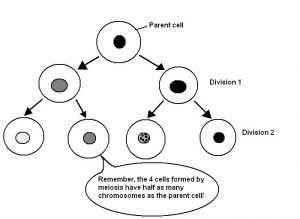Meiosis
Learning Objectives
Be able to describe the stages of meiosis.
Cells divide in two ways: mitosis and meiosis. Meiosis is cell division that results in the production of gametes, such as egg and sperm cells. Gametes are haploid. In humans, this means that they have 1 set of chromosomes instead of 2. The production of gametes is incredibly important because it allows for the recombination of genotypes through sexual reproduction. Thus, sexual reproduction can increase genetic variation which can lead to better chances of survival for the next generation of organisms. Genetic variation results in variable fitness which can lead to better chances of survival and reproduction for the next generation of offspring. Now that we have a better idea about meiosis on a larger scale, let’s take a look at how this process actually occurs:
We start with a parent cell. Notice that this cell has two sets of each chromosome. A chromosome is a bundle of genetic material that codes for specific things in an organism. Homologous chromosomes are a pair of chromosomes, one from each set, that code for the same things. These are homologous chromosomes. They are about the same size and shape and contain genes that code for the same things. They are not, however, identical. They may contain different alleles for specific genes.

MEIOSIS I:
Meiosis I is where 1 diploid parent cell divides into 2 haploid cells.
- Prophase:
In this stage, homologous chromosomes pair up to form tetrads. The formation of tetrads is also called synapsis. Something very important about tetrads is that they enable the homologous chromosomes to exchange segments of DNA, a process called crossing over. This process increases the genetic variation of the gametes. - Metaphase I:
In this stage, microtubules align the tetrads at the metaphase plate. I like to think that the tetrads “Meet in the Middle at the Metaphase plate” for some alliteration. - Anaphase I:
Next, the microtubules pull the homologous pairs apart to opposite ends of the cell. Notice that the sister chromatids stay together. - Telophase I:
Then, the cell divides. These two cells are now haploid, each containing one set of chromosomes.
MEIOSIS II:
Meiosis II is where sister chromatids separate. In other words, 2 haploid cells divide into 4 haploid daughter cells.
- Metaphase II:
Now, the chromatids are what “meet in the middle at the metaphase plate”. Crossing over does NOT occur between sister chromatids. - Anaphase II:
Microtubules separate sister chromatids, moving them to opposite poles of the cell. - Telophase II:
The cells split resulting in four haploid daughter cells, each with one set of unduplicated chromosomes.

To summarize, meiosis is a cellular process in which a diploid parent cell divides into four haploid daughter cells. One very important event in meiosis is crossing over, which occurs between prophase and metaphase I. Crossing over increases genetic variation. The haploid cells produced through meiosis are otherwise known as gametes. Gametes combine during sexual reproduction which also increases genetic diversity. Genetic diversity results in variable fitness which enhances the chances of survival for the next generation of organisms.
A type of cell division which results in two cells with a complete set of the parent cell's DNA
A type of cell division that results in four cells, each containing half of the parent cell's DNA
reproductive cells such as the ova and sperm
A cell with 23 unpaired chromosomes (half of the typical 46)
long strands of DNA carrying many genes; basic unit of inheritance.
The genetic make-up of an organism
the ability to survive and reproduce
a specific variant of a gene
A cell with 46 chromosomes, 23 from each parent
a group of four
The exchange of homologous segments of DNA to increase genetic diversity
Spiny structure of the cells which ensures chromosome duplication is done correctly
A pair of cells with identical DNA
The wide variety of alleles which make species more adaptable to change

